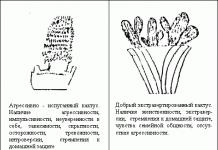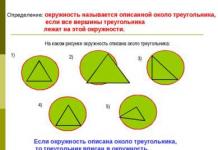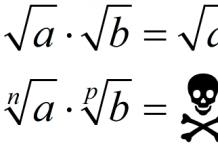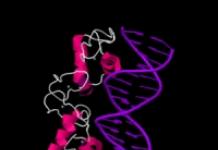Semiconductors are widely used in technology. The action of a semiconductor diode is based on different conductivity (p- and n-type). When semiconductors with p- and n-conductivity come into contact with a certain direction of current in the circuit, a barrier layer is created (Fig. 19.4) - a double electric layer, the field of which prevents the transfer of charge carriers. This is the basis of the action of the semiconductor diode, which serves to rectify alternating current. Selenium rectifiers were among the first to become widespread.
In addition to diodes, semiconductor triodes are also widely used in radio engineering - transistors in which there are two р-n junction: either p-n-p or n-p-n.
The strong temperature dependence of semiconductors is used in thermistors, highly sensitive devices for measuring temperature.
Among the many applications of semiconductors is also solar panels, the action of which is based on the photoconductivity of semiconductors - the ability to change resistance under the influence of light (a phenomenon similar to the photoelectric effect that occurs entirely inside a solid).
Magnetic forces
The magnetic properties of substances were known back in ancient times. Described by ancient scientists as a stone that attracts iron, it is a natural magnet - a mineral that is quite often found in nature. It consists of iron compounds (FeO - 31% and Fe 2 O 3 - 69%). Already in 1600, V. Gilbert’s work “On the Magnet, Magnetic Bodies and the Great Magnet of the Earth” was published, which contained a generalization of a large number of experimental facts. The main ones were as follows:
1) a magnet has two poles - north and south, different in their properties,
2) unlike poles attract, like poles repel;
3) the magnetic needle is located in space in a certain way, pointing north to south;
4) it is impossible to obtain a magnet with one pole;
5) The earth is a big magnet.
The nature of magnetic phenomena was revealed only after the establishment in the 19th century of experimental facts that electric current (moving charges) create a magnetic field (R. Erstad, 1820) Study of the interaction of conductors with currents, as a result of which it was found that parallel currents One direction attracts, and the opposite direction repels (J.Amper, I820), led to the conclusion that the forces of interaction between moving electric charges differ from the forces of interaction between stationary charges.
Additional forces arising between moving charges are called magnetic forces. This is due to the fact that they were discovered by the effect of current on a magnetic needle.
Thus, all magnetic disturbances can be reduced to electrical ones, and magnetic forces, as Einstein showed, there is a relativistic correction to Coulomb's law.
While there is no current in the conductors, no interaction forces arise between them, because the positive charge of the ions of the metal crystal lattice and the negative charge of the electrons are distributed evenly and the total charge inside the conductor is zero. In the presence of current, due to the movement of electrons, the average distance between them is reduced by a factor, where
V is the drift velocity of electrons. As a result, the electron charge density will increase by a factor of two and, therefore, the resulting charge will not be zero. This leads to the interaction of conductors.
Topics of the Unified State Examination codifier: semiconductors, intrinsic and impurity conductivity of semiconductors.
Until now, speaking about the ability of substances to conduct electric current, we have divided them into conductors and dielectrics. The resistivity of ordinary conductors is in the Ohm m range; The resistivity of dielectrics exceeds these values on average by orders of magnitude: Ohm m.
But there are also substances that, in their electrical conductivity, occupy an intermediate position between conductors and dielectrics. This semiconductors: their resistivity at room temperature can take values in a very wide range of Ohm m. Semiconductors include silicon, germanium, selenium, and some others chemical elements and compounds (Semiconductors are extremely common in nature. For example, about 80% of the mass earth's crust accounts for substances that are semiconductors). The most widely used are silicon and germanium.
main feature semiconductors is that their electrical conductivity increases sharply with increasing temperature. The resistivity of a semiconductor decreases with increasing temperature approximately as shown in Fig. 1 .

Rice. 1. Dependence for a semiconductor
In other words, at low temperatures semiconductors behave like dielectrics, and at high temperatures they behave like fairly good conductors. This is the difference between semiconductors and metals: the resistivity of a metal, as you remember, increases linearly with increasing temperature.
There are other differences between semiconductors and metals. Thus, illumination of a semiconductor causes a decrease in its resistance (and light has almost no effect on the resistance of the metal). In addition, the electrical conductivity of semiconductors can change greatly with the introduction of even minute amounts of impurities.
Experience shows that, as in the case of metals, no transfer of substance occurs when current flows through a semiconductor. Therefore, the electric current in semiconductors is caused by the movement of electrons.
A decrease in the resistance of a semiconductor when it is heated indicates that an increase in temperature leads to an increase in the number of free charges in the semiconductor. Nothing like this happens in metals; therefore, semiconductors have a different mechanism of electrical conductivity than metals. And the reason for this is the different nature chemical bond between metal and semiconductor atoms.
Covalent bond
The metallic bond, as you remember, is provided by a gas of free electrons, which, like glue, holds positive ions at the nodes of the crystal lattice. Semiconductors are structured differently - their atoms are held together covalent bond. Let's remember what it is.
Electrons located in the outer electronic level and called valence, are weaker bound to the atom than the remaining electrons, which are located closer to the nucleus. In the process of forming a covalent bond, two atoms contribute one of their valence electrons “to the common cause.” These two electrons are shared, that is, they now belong to both atoms, and therefore are called shared electron pair(Fig. 2).

Rice. 2. Covalent bond
A socialized pair of electrons is what holds the atoms near each other (using the forces of electrical attraction). A covalent bond is a bond that exists between atoms due to shared electron pairs. For this reason, a covalent bond is also called pair-electronic.
Crystal structure of silicon
Now we are ready to take a closer look at the internal structure of semiconductors. As an example, consider the most common semiconductor in nature - silicon. The second most important semiconductor, germanium, has a similar structure.
The spatial structure of silicon is shown in Fig. 3 (picture by Ben Mills). The balls represent silicon atoms, and the tubes connecting them are channels of covalent bonds between atoms.

Rice. 3. Crystal structure of silicon
Note that each silicon atom is bonded to four neighboring atoms. Why does this happen?
The fact is that silicon is tetravalent - there are four valence electrons on the outer electron shell of the silicon atom. Each of these four electrons is ready to form a shared electron pair with the valence electron of another atom. This is what happens! As a result, the silicon atom is surrounded by four atoms docked to it, each of which contributes one valence electron. Accordingly, there are eight electrons around each atom (four of our own and four of others).
We see this in more detail on a flat diagram of a silicon crystal lattice (Fig. 4).

Rice. 4. Silicon crystal lattice
Covalent bonds are depicted as pairs of lines connecting atoms; These lines contain common electron pairs. Each valence electron located on such a line spends most of its time in the space between two neighboring atoms.
However, valence electrons are by no means “tightly tied” to the corresponding pairs of atoms. Electronic shells overlap everyone neighboring atoms, so that any valence electron is the common property of all neighboring atoms. From some atom 1, such an electron can go to its neighboring atom 2, then to its neighboring atom 3, and so on. Valence electrons can move throughout the crystal - they are said to belong to the whole crystal(and not any one atomic pair).
However, silicon's valence electrons are not free (as is the case in the metal). In a semiconductor, the bond between valence electrons and atoms is much stronger than in a metal; Silicon covalent bonds do not break at low temperatures. The electron energy turns out to be insufficient to ensure that, under the influence of external electric field begin an orderly movement from a smaller potential to a larger one. Therefore, at sufficiently low temperatures, semiconductors are close to dielectrics - they do not conduct electric current.
Self conductivity
If you connect a semiconductor element to an electrical circuit and start heating it, the current in the circuit increases. Therefore, the resistance of the semiconductor decreases with increasing temperature. Why is this happening?
As the temperature rises, the thermal vibrations of silicon atoms become more intense, and the energy of the valence electrons increases. For some electrons, the energy reaches values sufficient to break covalent bonds. Such electrons leave their atoms and become free(or conduction electrons) - exactly the same as in metal. In an external electric field, free electrons begin to move in an orderly manner, forming an electric current.
The higher the silicon temperature, the greater the electron energy, and the more large quantity cannot withstand covalent bonds and breaks. The number of free electrons in a silicon crystal increases, which leads to a decrease in its resistance.
The breaking of covalent bonds and the appearance of free electrons is shown in Fig. 5 . At the site of the broken covalent bond, a hole- vacant place for an electron. The hole has positive charge, since with the departure of a negatively charged electron, an uncompensated positive charge of the nucleus of the silicon atom remains.

Rice. 5. Formation of free electrons and holes
The holes do not stay in place - they can wander around the crystal. The fact is that one of the neighboring valence electrons, “traveling” between atoms, can jump to the resulting vacant place, filling the hole; then the hole in this place will disappear, but will appear in the place where the electron came from.
In the absence of an external electric field, the movement of holes is random, because valence electrons wander randomly between atoms. However, in an electric field it begins directed movement of holes. Why? This is not difficult to understand.
In Fig. Figure 6 shows a semiconductor placed in an electric field. On the left side of the picture is the initial position of the hole.

Rice. 6. Motion of a hole in an electric field
Where will the hole go? It is clear that the most likely electron > hole jumps are in the direction against field lines (that is, to the “pluses” that create the field). One of these jumps is shown in the middle part of the figure: the electron jumped to the left, filling the vacancy, and the hole, accordingly, shifted to the right. The next possible electron jump caused by the electric field is depicted on the right side of the figure; as a result of this jump, the hole took a new place, located even further to the right.
We see that the hole as a whole is moving towards field lines - that is, where positive charges are supposed to move. Let us emphasize once again that the directed movement of a hole along the field is caused by jumps of valence electrons from atom to atom, occurring predominantly in the direction against the field.
Thus, in a silicon crystal there are two types of charge carriers: free electrons and holes. When an external electric field is applied, an electric current appears, caused by their ordered counter motion: free electrons move opposite to the field strength vector, and holes - in the direction of the vector.
The generation of current due to the movement of free electrons is called electronic conductivity, or n-type conductivity. The process of orderly movement of holes is called hole conductivity,or p-type conductivity(from the first letters of the Latin words negativus (negative) and positivus (positive)). Both conductivities - electron and hole - are collectively called own conductivity semiconductor.
Each electron leaving a broken covalent bond generates a “free electron–hole” pair. Therefore, the concentration of free electrons in the crystal pure silicon equal to the hole concentration. Accordingly, when the crystal is heated, the concentration of not only free electrons, but also holes increases, which leads to an increase in the intrinsic conductivity of the semiconductor due to an increase in both electron and hole conductivity.
Along with the formation of free electron–hole pairs, the reverse process also occurs: recombination free electrons and holes. Namely, a free electron, encountering a hole, fills this vacancy, restoring the broken covalent bond and turning into a valence electron. Thus, in a semiconductor it is established dynamic equilibrium: the average number of ruptures of covalent bonds and the formation of electron-hole pairs per unit time is equal to the average number of recombining electrons and holes. This state of dynamic equilibrium determines the equilibrium concentration of free electrons and holes in the semiconductor under given conditions.
Changes in external conditions shift the state of dynamic equilibrium in one direction or another. In this case, the equilibrium value of the charge carrier concentration naturally changes. For example, the number of free electrons and holes increases when the semiconductor is heated or illuminated.
At room temperature, the concentration of free electrons and holes in silicon is approximately equal to cm. The concentration of silicon atoms is on the order of cm. In other words, there is only one free electron per silicon atom! This is very little. In metals, for example, the concentration of free electrons is approximately equal to the concentration of atoms. Respectively, intrinsic conductivity of silicon and other semiconductors at normal conditions small compared to the conductivity of metals.
Impurity conductivity
The most important feature of semiconductors is that their resistivity can be reduced by several orders of magnitude as a result of the introduction of even a very small amount of impurities. In addition to its own conductivity, a semiconductor has a dominant impurity conductivity. It is thanks to this fact that semiconductor devices have found such wide application in science and technology.
Suppose, for example, that a little pentavalent arsenic is added to the silicon melt. After crystallization of the melt, it turns out that arsenic atoms occupy places in some nodes of the formed silicon crystal lattice.
The outermost electronic level of the arsenic atom has five electrons. Four of them form covalent bonds with their nearest neighbors - silicon atoms (Fig. 7). What is the fate of the fifth electron not occupied in these bonds?

Rice. 7. N-type semiconductor
And the fifth electron becomes free! The fact is that the binding energy of this “extra” electron with the arsenic atom located in the silicon crystal is much less than the binding energy of valence electrons with silicon atoms. Therefore, already at room temperature, almost all arsenic atoms, as a result of thermal movement, remain without a fifth electron, turning into positive ions. And the silicon crystal, accordingly, is filled with free electrons that have been detached from the arsenic atoms.
Filling a crystal with free electrons is not new to us: we saw this above when it was heated clean silicon (without any impurities). But now the situation is fundamentally different: the appearance of a free electron leaving an arsenic atom is not accompanied by the appearance of a mobile hole. Why? The reason is the same - the bond of valence electrons with silicon atoms is much stronger than with the arsenic atom in the fifth vacancy, therefore the electrons of neighboring silicon atoms do not tend to fill this vacancy. The vacancy thus remains in place; it is, as it were, “frozen” to the arsenic atom and does not participate in the creation of current.
Thus, the introduction of pentavalent arsenic atoms into the silicon crystal lattice creates electronic conductivity, but does not lead to the symmetrical appearance of hole conductivity. The main role in creating current now belongs to free electrons, which in this case are called main carriers charge.
The mechanism of intrinsic conductivity, of course, continues to work even in the presence of an impurity: covalent bonds are still broken due to thermal motion, generating free electrons and holes. But now there are much fewer holes than free electrons, which are provided in large quantities by arsenic atoms. Therefore, in this case the holes will be non-major media charge.
Impurities whose atoms give up free electrons without the appearance of an equal number of mobile holes are called donor. For example, pentavalent arsenic is a donor impurity. If there is a donor impurity in a semiconductor, the majority charge carriers are free electrons, and the minority charge carriers are holes; in other words, the concentration of free electrons is much higher than the concentration of holes. Therefore, semiconductors with donor impurities are called electronic semiconductors, or n-type semiconductors(or simply n-semiconductors).
And how much, interestingly, can the concentration of free electrons exceed the concentration of holes in an n-semiconductor? Let's do a simple calculation.
Let us assume that the impurity is , that is, there is one arsenic atom per thousand silicon atoms. The concentration of silicon atoms, as we remember, is of the order of cm.
The concentration of arsenic atoms, accordingly, will be a thousand times less: cm. The concentration of free electrons given up by the impurity will also be the same - after all, each arsenic atom gives up an electron. Now let us remember that the concentration of electron-hole pairs that appear when silicon covalent bonds are broken at room temperature is approximately equal to cm. Do you feel the difference? The concentration of free electrons in this case is greater than the concentration of holes by orders of magnitude, that is, a billion times! Accordingly, the resistivity of a silicon semiconductor decreases by a billion times when such a small amount of impurity is introduced.
The above calculation shows that in n-type semiconductors the main role is indeed played by electronic conductivity. Against the background of such a colossal superiority in the number of free electrons, the contribution of hole movement to the overall conductivity is negligible.
On the contrary, it is possible to create a semiconductor with predominant hole conductivity. This will happen if a trivalent impurity is introduced into a silicon crystal - for example, indium. The result of such implementation is shown in Fig. 8 .

Rice. 8. P-type semiconductor
What happens in this case? The outermost electronic level of the indium atom contains three electrons that form covalent bonds with the three surrounding silicon atoms. For the fourth neighboring silicon atom, the indium atom no longer has enough electron, and a hole appears in this place.
And this hole is not simple, but special - with a very high binding energy. When an electron from a neighboring silicon atom gets into it, it will “get stuck in it forever,” because the attraction of the electron to the indium atom is very strong - more than to silicon atoms. The indium atom will turn into a negative ion, and a hole will appear in the place where the electron came from - but now an ordinary mobile hole in the form of a broken covalent bond in the silicon crystal lattice. This hole will begin to wander around the crystal in the usual way due to the “relay race” transfer of valence electrons from one silicon atom to another.
And so, each impurity indium atom generates a hole, but does not lead to the symmetric appearance of a free electron. Such impurities, the atoms of which “tightly” capture electrons and thereby create a mobile hole in the crystal, are called acceptor.
Trivalent indium is an example of an acceptor impurity.
If an acceptor impurity is introduced into a crystal of pure silicon, then the number of holes generated by the impurity will be much greater than the number of free electrons created due to the breaking of covalent bonds between silicon atoms. A semiconductor with an acceptor impurity is hole semiconductor, or p-type semiconductor(or simply p-semiconductor).
Holes play main role when creating a current in a p-semiconductor; holes - main charge carriers. Free electrons - minor media charge in a p-semiconductor. The movement of free electrons in this case does not make a significant contribution: the electric current is provided primarily by hole conductivity.
p–n junction
The place of contact between two semiconductors with different types of conductivity (electronic and hole) is called electron-hole transition, or p–n junction. In the region of the p–n junction, an interesting and very important phenomenon occurs - one-way conductivity.
In Fig. 9 shows the contact of p- and n-type regions; the colored circles are holes and free electrons, which are the majority (or minority) charge carriers in the corresponding regions.

Rice. 9. Blocking layer of the p–n junction
Committing thermal movement, charge carriers penetrate through the interface between the regions.
Free electrons move from the n-region to the p-region and recombine there with holes; holes diffuse from the p-region to the n-region and recombine there with electrons.
As a result of these processes, an uncompensated charge of positive ions of the donor impurity remains in the electronic semiconductor near the contact boundary, and an uncompensated negative charge of the acceptor impurity ions appears in the hole semiconductor (also near the boundary). These uncompensated space charges form the so-called barrier layer, the internal electric field of which prevents further diffusion of free electrons and holes across the contact boundary.
Let us now connect a current source to our semiconductor element, applying the “plus” of the source to the n-semiconductor, and the “minus” to the p-semiconductor (Fig. 10).

Rice. 10. Turning on in reverse direction: no current
We see that the external electric field moves the majority charge carriers further from the contact boundary. The width of the blocking layer increases, and its electric field increases. The resistance of the blocking layer is high, and majority carriers are not able to overcome the p–n junction. The electric field allows only minority carriers to cross the boundary, but due to the very low concentration of minority carriers, the current they create is negligible.
The considered scheme is called turning on the p–n junction in the opposite direction. There is no main carrier electric current; there is only a negligible minority carrier current. In this case, the p–n junction turns out to be closed.
Now let’s change the polarity of the connection and apply “plus” to the p-semiconductor, and “minus” to the n-semiconductor (Fig. 11). This scheme is called inclusion in forward direction .

Rice. 11. Switching on in the forward direction: current flows
In this case, the external electric field is directed against the blocking field and opens the way for majority carriers through the p–n junction. The barrier layer becomes thinner and its resistance decreases.
There is a massive movement of free electrons from the n-region to the p-region, and holes, in turn, rush together from the p-region to the n-region.
A current arises in the circuit caused by the movement of the majority charge carriers (Now, however, the electric field interferes with the current of the minority carriers, but this insignificant factor does not have a noticeable effect on the overall conductivity).
One-way conductivity of the p–n junction is used in semiconductor diodes. A diode is a device that conducts current in only one direction; in the opposite direction, no current passes through the diode (the diode is said to be closed). A schematic representation of the diode is shown in Fig. 12 .

Rice. 12. Diode
In this case, the diode is open in the direction from left to right: the charges seem to flow along the arrow (see it in the figure?). In the direction from right to left, the charges seem to rest against the wall - the diode is closed.
Semiconductors got their name because they occupy an intermediate position between conductors (metals, electrolytes, etc.), which have high electrical conductivity, and insulators (porcelain, mica, rubber, and others), which have almost no conductivity.
If we compare the specific in Ohm × cm for various substances, then it turns out that the conductors have: ρ U= 10 -6 - 10 -3 Ohm × cm; resistivity of semiconductors: ρ U= 10 -3 - 10 8 Ohm × cm; and y: ρ U= 10 8 - 10 20 Ohm × cm. Semiconductors include: metal oxides - oxides (Al 2 O 3, Cu 2 O, ZnO, TiO 2, VO 2, WO 2, MoO 3); sulfur compounds - sulfides (Cu 2 S, Ag 2 S, ZnS, CdS, HgS); compounds with selenium - selenides; compounds with tellurium - tellurides; some alloys (MgSb 2, ZnSb, Mg 2 Sb, CdSb, AlSb, ClSb); chemical elements - germanium, silicon, tellurium, selenium, boron, carbon, sulfur, phosphorus, arsenic, as well as big number complex compounds (galene, carborundum and others).
Figure 1. Germanium
![]()
Figure 2. Silicon

Figure 3. Tellurium
A complete and extensive study of the properties of semiconductors was carried out by the Soviet scientist A.F. Ioffe and his colleagues.
The electrical properties of semiconductors differ sharply from the properties of conductors and insulators. The electrical conductivity of conductors strongly depends on temperature, illumination, the presence and intensity of the electric field, and the amount of impurities. At ordinary temperatures, semiconductors contain a certain number of free electrons resulting from the breaking of electronic bonds. There are two types of semiconductors: electron and hole. Charge carriers in semiconductors with electronic conduction are free electrons, and with hole conduction they are bonds devoid of electrons.
Consider the following experiment. Let's take and heat one end of it, then the heated end of the conductor will receive a positive charge. This is due to the movement of electrons from the hot end to the cold end, resulting in a shortage of electrons at the hot end of the conductor (positive charge) and an excess of electrons at the cold end (negative charge). The short-term flow of current through a conductor was caused by the movement of electrons from one end of the conductor to the other. So here we're talking about about a conductor with electronic conductivity. However, there are substances that behave differently during such an experiment: the heated edge of such a substance receives a negative charge, and the cold edge receives a positive charge. This is possible if we assume that current transfer is carried out by positive charges.

Figure 4. Bonding between atoms of a substance
 |
| Figure 5. Intrinsic conductivity of semiconductors |
 |
| Figure 6. Electronic conductivity of a semiconductor |
 |
| Figure 7. Hole conductivity of a semiconductor |
Let's get acquainted with another type of conductivity in semiconductors - hole conductivity. In pure semiconductors, all electrons weakly bound to the nuclei participate in electronic communications. In Figure 4, A the filled bond between the atoms of the substance is conventionally shown. A "hole" is an element crystal lattice substances that have lost an electron, which corresponds to the appearance of a positive charge (Figure 4, b).
A released bond may be filled again if the “hole” captures an electron from a neighboring bond (Figure 4, V). This will cause the "hole" to move to a new location. In a semiconductor substance under normal conditions, the direction of electron emission and the location of the “hole” formation are chaotic. If a constant voltage is applied to a pure semiconductor, then electrons and “holes” will move (the first against the direction of the field forces, the second in the opposite direction). If the number of “holes” formed is equal to the number of released electrons, then, as is the case with pure semiconductors, the conductivity of semiconductors is low (intrinsic conductivity). The presence of even a small amount of foreign impurities can change the mechanism of electrical conductivity: make it electronic or hole. Let's look at a specific example. Let's take germanium (Ge) as a semiconductor. In a germanium crystal, each atom is bonded to four other atoms. When the temperature increases or as a result of irradiation, the pair bonds of the crystal can be broken. In this case, an equal number of electrons and “holes” are formed (Figure 5).
Let's add arsenic to germanium as an impurity. Such an impurity has a large number of weakly bound electrons. Impurity atoms have their own energy level, located between the energy levels of the free and filled bands, closer to the latter (Figure 6). Such impurities give up their electrons to the free zone and are called donor impurities. The semiconductor will have free electrons, while all bonds will be filled. The semiconductor will have electronic conductivity in the free band.
If now indium, rather than arsenic, is added as an impurity to germanium, the following will happen. Such an impurity has a small number of weakly bound electrons, and the energy level of the impurity is located between the energy levels of the free and filled zones, closer to the free zone (Figure 7). Impurities of this kind accept electrons into their zone from an adjacent filled zone and are called acceptor impurities. In the semiconductor there will be unfilled bonds - “holes” in the absence of free electrons. The semiconductor will have hole conductivity in the filled band.
Now the experience of heating a semiconductor will become clear, when the heated end received a negative charge, and the cold end received a positive charge. Under the influence of heat, bonds at the hot end will begin to break down, creating “holes” and free electrons. If the semiconductor contains impurities, then the “holes” will begin to move to the cold end, charging it positively, and the heated end of the semiconductor will become negatively charged.
Concluding our consideration of semiconductors, we draw the following conclusion.
By adding impurities to a semiconductor, one can give it predominant electronic or hole conductivity. Based on this, the following types of semiconductors are obtained. Semiconductors with electronic conductivity are called semiconductors n-type (negative), and with hole conductivity - p-type (positive).
We also invite you to watch educational videos about semiconductors:
List=PL_QCOTUIndSFAbWcR3t0wYp5IORVEHu3I
A semiconductor is a crystalline material that conducts electricity not as well as metals, but not as poorly as most insulators. In general, the electrons of semiconductors are tightly bound to their nuclei. However, if several atoms of antimony, which have an “excess” of electrons, are introduced into a semiconductor, for example, silicon, then in this case the free electrons of antimony will help the silicon carry a negative charge.
When several atoms of a semiconductor are replaced by indium, which easily attaches additional electrons to itself, “free spaces” or, as physicists say, “holes” are formed in the semiconductor; which carry a positive charge.
These properties of semiconductors have led to their widespread use in transistors - devices for amplifying current, blocking it, or passing it in only one direction. In a typical NPN transistor, a layer of positive (P) semiconductor (base) is sandwiched between two layers of negative (N) semiconductor (emitter and collector). When a weak signal, such as from an intercom, passes through the base of the NPN transistor, electron emission amplifies the signal.
Structure of semiconductors

N-type semiconductors contain an excess number of electrons that carry a negative charge. P-type semiconductors lack electrons, but have an excess of holes (vacant spaces for electrons) that carry positive charge.
Distinctive features of semiconductors

Unlike conductors, which have many free electrons, and insulators, which have virtually none, semiconductors contain a small number of free electrons and so-called holes (white circle) - vacant spaces left by free electrons. Both holes and electrons conduct electric current.
NPN transistor

PNP transistor
The holes move from the positive emitter (+) to the negative base (N-layer) and then through the positive collector to the negative terminal (-), amplifying the electrical current.
What is a diode?

In one direction yes, in the other - no. The diode input signal indicates alternating current; From the right graph you can see that only direct current passes through the diode.

When negatively charged electrons (blue balls) and positively charged holes (pink balls) move away from the junction of the N-type and P-type silicon layers in the diode, the electrical current is interrupted. In the lower right picture, electrons and holes move towards the junction, and as a result, the diode conducts current in only one direction, turning alternating current into direct current.
Add site to bookmarks
What are the basic properties of semiconductors?
By electrical resistance semiconductors occupy an intermediate position between conductors and insulators. Semiconductor diodes and triodes have a number of advantages: low weight and size, significantly longer service life, and greater mechanical strength.
Let's consider the basic properties and characteristics of semiconductors. Regarding them electrical conductivity Semiconductors are divided into 2 types: with electronic and hole conductivity.
Semiconductors with electronic conductivity have so-called free electrons, which are weakly bound to the nuclei of atoms.

If a potential difference is applied to this semiconductor, the free electrons will move forward - in a certain direction, thus creating an electric current. Since in these types of semiconductors the electric current represents the movement of negatively charged particles, they are called type n conductors (from the word negative). Semiconductors with hole conductivity are called p-type semiconductors (from the word positive). Walkthrough electric current
The absence of one electron in an atom, causing a positive charge on a semiconductor atom, is called a hole (this means that a free space has formed in the atom). Theory and experience show that holes behave like elementary positive charges.
Hole conductivity consists in the fact that, under the influence of an applied potential difference, holes move, which is equivalent to the movement of positive charges.
In reality, the following occurs during hole conduction. Let's assume that there are 2 atoms, one of which is equipped with a hole (one electron is missing in the outer orbit), and the other, located on the right, has all the electrons in place (let's call it a neutral atom). If a potential difference is applied to a semiconductor, then, under the influence of an electric field, an electron from a neutral atom, which has all the electrons in its place, will move to the left to the atom equipped with a hole.

Due to this, the atom that had the hole becomes neutral, and the hole moves to the right to the atom from which the electron has left. In semiconductor devices, the process of “filling” a hole with a free electron is called recombination. As a result of recombination, both the free electron and the hole disappear, and a neutral atom is created. And so the movement of holes occurs in the direction opposite to the movement of electrons.
In an absolutely pure (intrinsic) semiconductor, under the influence of heat or light, electrons and holes are born in pairs, therefore the number of electrons and holes in the intrinsic semiconductor is the same.
To create semiconductors with pronounced concentrations of electrons or holes, pure semiconductors are supplied with impurities, forming impurity semiconductors. Impurities are donor, giving electrons, and acceptor, forming holes (i.e., tearing electrons away from atoms). Consequently, in a semiconductor with a donor impurity, the conductivity will be predominantly electronic, or n-conductivity. In these semiconductors, the majority charge carriers are electrons and the minority charge carriers are holes. In a semiconductor with an acceptor impurity, on the contrary, the majority charge carriers are holes, and the minority charge carriers are electrons; These are semiconductors with p-conductivity.
The main materials for the manufacture of semiconductor diodes and triodes are germanium and silicon; in relation to them, donors are antimony, phosphorus, arsenic; acceptors - indium, gallium, aluminum, boron.

Figure 1. Location electric charges in a semiconductor.
Impurities, which are typically added to a crystalline semiconductor, dramatically change the physical pattern of electrical current flow.
When a semiconductor with n-conductivity is formed, a donor impurity is added to the semiconductor: for example, an antimony impurity is added to a germanium semiconductor. Antimony atoms, which are donors, impart many free electrons to germanium, thereby becoming positively charged.
Thus, in an n-conductivity semiconductor formed by an impurity, there are the following types of electrical charges:
- mobile negative charges (electrons), which are the main carriers (both from the donor impurity and from their own conductivity);
- mobile positive charges (holes) - minority carriers arising from their own conductivity;
- immobile positive charges - donor impurity ions.
When a semiconductor with p-conductivity is formed, an acceptor impurity is added to the semiconductor: for example, an indium impurity is added to a germanium semiconductor. Indium atoms, which are acceptors, remove electrons from germanium atoms, forming holes. The indium atoms themselves become negatively charged.
Consequently, in a semiconductor of p-conductivity there are the following types of electric charges:
- mobile positive charges (holes) - the main carriers arising from the acceptor impurity and from their own conductivity;
- mobile negative charges (electrons) - minority carriers arising from their own conductivity;
- immobile negative charges - acceptor impurity ions.
In Fig. Figure 1 shows p-germanium (a) and n-germanium (b) plates with the arrangement of electric charges.


























